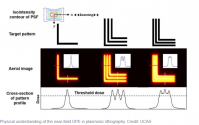Scientists improve near-field optical proximity correction via spatial modulation
Researchers led by Prof. Wei Yayi from the University of Chinese Academy of Sciences (UCAS) have improved the final pattern fidelity in near-field nanolithography, a breakthrough in understanding the near-field diffraction limit of an evanescent-field-based patterning system.
The results, published in Microsystems & Nanoengineering, is the first to investigate the physical origin of the near-field optical proximity effect (OPE), and the theoretical calculations and simulation results indicate that the evanescent-field-induced rapid loss of high-k information is one of the main optical contributors to the near-field OPE.
As the feature size is continuously scaled down, the pattern profile generated by a near-field lithography exhibits very poor pattern quality due to the near-field OPE, far below the minimum requirement for nanofabrication. Therefore, it is essential to minimize the near-field OPE in order to achieve the highest pattern resolution and fidelity possible with the plasmonic lithography process.
In this study, the researchers investigated the physical concepts behind the near-field OPE in a maskless plasmonic lithography, and proposed a near-field optical proximity correction (OPC) method via the spatial modulation of nanopatterns to improve the final pattern quality.

